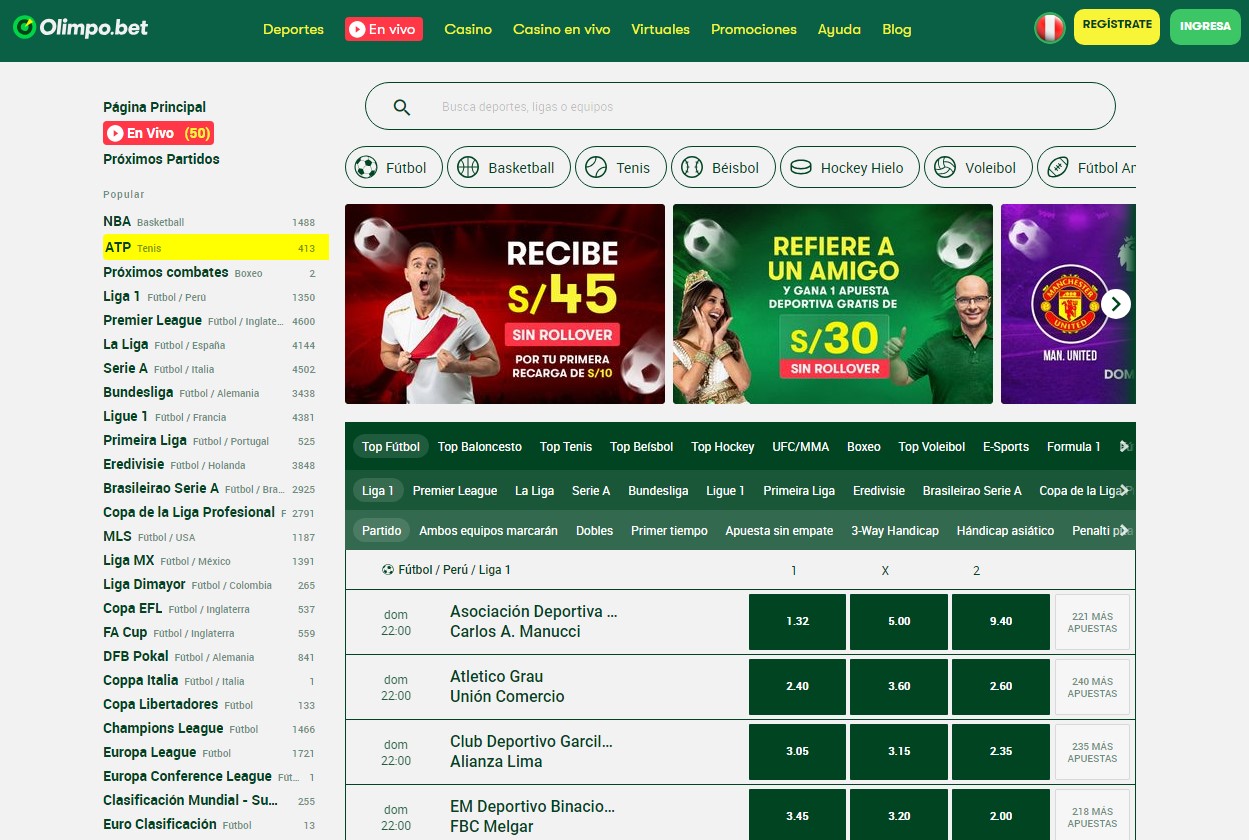Olimpo bet es una nueva casa de apuestas deportivas y casino online que ha llegado recientemente al mercado peruano. Esta plataforma ofrece una amplia variedad de opciones de juego y atractivas promociones para todos los jugadores en Perú.

Los principales atractivos de Olimpo.bet incluyen apuestas deportivas en vivo con cuotas competitivas, cientos de tragamonedas y juegos de casino, métodos de pago locales convenientes, y un servicio al cliente disponible 24/7.
Olimpo bet es legal en Perú?
Si bien las apuestas deportivas online o betting aún no están reguladas en Perú, Olimpo.bet opera con total legalidad bajo una licencia otorgada en Curacao, un territorio reconocido a nivel internacional por el alto nivel técnico de sus marcos regulatorios en la industria de casinos y apuestas online.
Olimpo bet Perú cumple con todos los estándares técnicos y legales requeridos para operar, utilizando un sofisticado sistema de encriptación para proteger los datos personales y transacciones financieras de sus usuarios. La plataforma también promueve el juego responsable.
Jugar en casas de apuestas deportivas licenciadas y seguras como Olimpo.bet es siempre la mejor opción, comparado con operadores informales sin ningún tipo de regulación ni garantías. Esto protege tu dinero y datos personales, además de darte acceso a mejores promociones y mayor variedad de opciones de apuestas.
Opciones de juego en Olimpo bet Perú
Los usuarios de Olimpo bet Perú pueden disfrutar de una amplísima gama de ligas deportivas para sus apuestas:
- Fútbol
- Tenis
- Baloncesto
- Voleibol
- Futsal
- Boxeo
- E-Sports
- Béisbol
- Tenis de mesa
- Hockey sobre hielo
- Rugby
- Cricket
- Golf
- Fórmulas 1, 2 y 3
- Ciclismo
- NFL
- UFC
- ATP/WTA
Y muchos otros deportes con múltiples campeonatos cubiertos cada semana.

Además de las tradicionales apuestas pre-partido con altas cuotas, Olimpo bet Perú destaca por ofrecer una gran cantidad de mercados en vivo durante el desarrollo de los juegos. Entre los más populares están:
- Resultado final
- Primer goleador
- Ambos equipos anotan
- Total de goles
- Resultado exacto
- Próximo equipo en anotar
- Total de corners
- Total tarjetas
- Posición final de pilotos de F1
- Ganador del set/juego/tiebreak
Así los usuarios nunca se aburrirán explorando nuevas oportunidades de apuestas para maximizar sus ganancias.
Sección de casino
En la sección casino de Olimpo.bet los jugadores de Perú podrán disfrutar de populares juegos de azar online producidos por los mejores proveedores del mercado como:
- Tragamonedas
- Ruleta
- Blackjack
- Poker
- Baccarat
- Dados
Con modalidades en vivo que permiten interactuar con crupieres en tiempo real para mayor entretenimiento.
También hay disponibles torneos diarios de casino, juego responsable y estrictos controles para evitar cualquier actividad fraudulenta. Permitiendo que tanto jugadores principiantes como veteranos puedan disfrutar plenamente de la emoción del casino online.

Juegos virtuales
Olimpo.bet Perú incluye una sección de juegos virtuales con simuladores deportivos altamente realistas generados por computadora que permiten apostar en carreras de caballos, carreras de galgos o fútbol fantasía con jugadores legendarios. ¡Una excelente alternativa para aquellos que buscan acción las 24 horas!
En resumen, con su amplia variedad de deportes, mercados y secciones especializadas, Olimpo.bet ofrece el catálogo de apuestas online más completo para el jugador peruano. Siempre encontrarás múltiples opciones para ganar apostando desde tu computadora o celular.
Bonos y promociones para jugadores peruanos
La oferta de bonos y promociones de Olimpo bet Peru está especialmente adaptada para satisfacer las necesidades de los apostadores locales. Comenzando con un generoso paquete exclusivo para nuevos usuarios:
Bono de bienvenida
- 100% de bonificación sobre el primer depósito hasta 1000 PEN
- Reembolso del 50% en caso de pérdidas durante los primeros 7 días hasta 500 PEN
Estos bonos permiten a los jugadores peruanos empezar su experiencia en Olimpo.bet con un gran capital para explorar las apuestas deportivas y distintos juegos de casino, teniendo además un “seguro” contra posibles pérdidas al comienzo.
Para recibir este bono solo hay que:
- Registrarse con un nombre de usuario y contraseña
- Verificar la identidad enviando el DNI por ambos lados
- Realizar un primer depósito mínimo de 20 PEN en la caja registradora
El bono se acreditará en la cuenta en menos de 24 horas hábiles.
Luego de agotar el bono inicial, los usuarios de Perú podrán aprovechar promociones recurrentes como:
- Bonos de recarga todos los miércoles del 50% hasta 500 PEN
- Cashback semanal de 10% sobre las pérdidas netas hasta 200 PEN
- 10 giros gratis todos los viernes en tragamonedas populares
- Acceso anticipado a eventos deportivos especiales con cuotas boosteadas
Y también hay promociones especiales en días festivos como Fiestas Patrias, Navidad o el día del Pisco Sour.
¡En Olimpo.bet los bonos nunca se acaban! Siempre hay una oportunidad disponible para incrementar tu bankroll y maximizar las ganancias.

🕹️ Métodos de pago disponibles en Olimpo bet Perú
Realizar depósitos y retiros en Olimpo.bet Perú es muy conveniente gracias a que la plataforma acepta las principales opciones bancarias locales.
Depósitos
- Transferencia / Depósito bancario
- BCP
- BBVA Continental
- Interbank
- Scotiabank
- Banca por internet
- BCP
- Interbank
- BBVA Continental
- Billeteras digitales
- Yape
- Tunki
- Lukita
- PayPal
- Tarjetas de débito y crédito
- Visa
- Mastercard
Los depósitos son gratis y se procesan en el acto, permitiendo a los usuarios comenzar a apostar en minutos.
Retiros
El dinero ganado se puede retirar mediante:
- Transferencia bancaria a cuentas locales (1-3 días hábiles)
- Billeteras digitales (1-12 horas)
Todos los retiros son gratis para los usuarios de Perú, con un límite de 5000 PEN por transacción.
Esta amplia variedad de métodos de pago con procesamiento rápido y sin comisiones ocultas convierten a Olimpo.bet en una plataforma de apuestas en línea sumamente cómoda y adaptada a las necesidades locales.
Atención al cliente de Olimpo bet Perú
Olimpo.bet Perú cuenta con un equipo profesional de atención al cliente 100% dedicado a resolver todas las consultas técnicas o transaccionales de sus usuarios.
Los canales disponibles para contactar al soporte son:
- Chat en vivo dentro del sitio web
- Línea telefónica gratuita
- Correo electrónico a [email protected]
Funcionando las 24 horas, todos los días de la semana. Con agentes capacitados para ofrecer asistencia tanto en español como en inglés.
Además de resolver problemas, el equipo de atención al cliente también puede ayudar con:
- Recomendaciones sobre apuestas y juegos de casino
- Asesoría para aprovechar bonos y promociones
- Ayuda con depósitos y retiros
- Bloqueos temporales de cuenta
- Verificación de identidad
Y cualquier otro inconveniente. Siempre enfocándose en brindar la mejor experiencia posible a los usuarios de Perú.
Contar con varios medios de contacto y soporte profesional 24/7 es invaluable para los jugadores. En especial cuando surgen dudas técnicas frecuentes al operar una cuenta de apuestas online.

Registro y primeros pasos en Olimpo bet Perú
Abrir una cuenta de usuario en Olimpo.bet Perú es muy sencillo, solo se requiere:
- Ingresar a la página web Olimpo.bet/pe/ desde una computadora o celular.
- Hacer clic en “Regístrate Ya” en el menú superior.
- Ingresar un nombre de usuario, contraseña, correo electrónico y número de celular activo.
- Confirmar la cuenta mediante el código enviado vía mensaje de texto.
- Completar el formulario con todos los datos personales solicitados.
- Subir una fotografía por ambos lados del DNI para validar la identidad.
- ¡Listo! La cuenta queda activa para comenzar a jugar.
Todo este proceso no toma más de 5 minutos.
Una vez con la cuenta verificada, los nuevos usuarios de Perú ya pueden:
- Explorar los mercados y eventos disponibles para comenzar a realizar apuestas deportivas.
- Depositar mediante su método de pago preferido para tener saldo para apostar.
- Reclamar el bono de bienvenida del 100% hasta 1000 PEN haciendo su primer depósito.
- Probar diferentes juegos de casino y tragamonedas en la sección de Olimpo.bet Casino.
- Configurar límites de apuestas y otras opciones de responsabilidad.
- Contactar al servicio al cliente ante cualquier duda.
Registrarse en Olimpo.bet es fácil y rápido. En minutos los nuevos usuarios ya pueden disfrutar de toda la emoción de las apuestas deportivas y el casino online, con la seguridad y respaldo de una marca líder internacional.
Olimpo bet vs. otras casas de apuestas en Perú
Veamos un comparativo de Olimpo.bet Perú frente a otras conocidas casas de apuestas legales disponibles para los usuarios locales:
| Características | Olimpo.bet | Betsson | Inkabet | Betfair |
|---|---|---|---|---|
| Años en el mercado | 1 | 20 | 10 | 22 |
| Licencias | Curacao | Malta, Reino Unido | Perú | Gibraltar |
| Deportes disponibles | 28 | 20 | 15 | 22 |
| Mercados de apuestas | +100 | +50 | +40 | +150 |
| Apuestas en vivo | Sí | Sí | No | Sí |
| Casino online | Sí | Sí | No | No |
| Slots y tragamonedas | +150 | +100 | N/A | N/A |
| Límites de apuestas | Altos | Medios | Bajos | Altos |
| Soporte en español | 24/7 | Limitado | No | No |
| Apps móviles | Sí | No | Sí | Sí |
| Retiros en soles | Sí | No | Sí | No |
| Bono de bienvenida | 100% hasta S/ 1000 | 100% hasta $200 | 50% hasta S/ 100 | N/A |
Como se observa, Olimpo.bet representa una opción muy competitiva y a menudo superior en varios aspectos críticos como variedad de apuestas, límites altos, bonos atractivos, buena atención al cliente y procesamiento de pagos en soles peruanos.
Comparada con casas de apuestas ya posicionadas como Betsson y Betfair, Olimpo.bet iguala o mejora la mayoría de características. Mientras que frente a opciones más pequeñas como Inkabet, claramente tiene superioridad en áreas como apuestas en vivo, juegos de casino, límites o promociones.
Tomando en cuenta todos estos factores, Olimpo.bet se perfila como una de las mejores y más completas casas de apuestas disponibles actualmente para los usuarios de Perú. Ofreciendo una experiencia de juego de primer nivel global ahora adaptada específicamente para los jugadores peruanos.
Conclusión
En resumen, Olimpo bet representa un nuevo estándar para las apuestas deportivas y casino online en Perú, con una plataforma diseñada pensando 100% en las necesidades locales:
- Legalidad garantizada mediante licencia internacional
- Amplia variedad de deportes y mercados para apostar
- Casino online completo con tragamonedas y juegos de mesa
- Atractivo bono de bienvenida de 1000 PEN + cashback
- Métodos de pago peruanos y soporte 24/7 en español
- Fácil registro y verificación de cuenta en minutos
Los jugadores en Perú que buscan una experiencia premium de apuestas y casino online legal, segura y regulada no deben mirar más allá de Olimpo.bet.
Únete hoy para recibir el exclusivo bono de bienvenida y comenzar a ganar con las mejores cuotas del mercado peruano.
Answers to Your Questions
¿Cuáles son los horarios de atención al cliente?
¿Puedo apostar desde mi celular?
¡Por supuesto! La app móvil de Olimpo para Android e iOS te permite registrarte, depositar y retirar fondos, hacer apuestas deportivas en vivo y jugar casino desde cualquier lugar.
